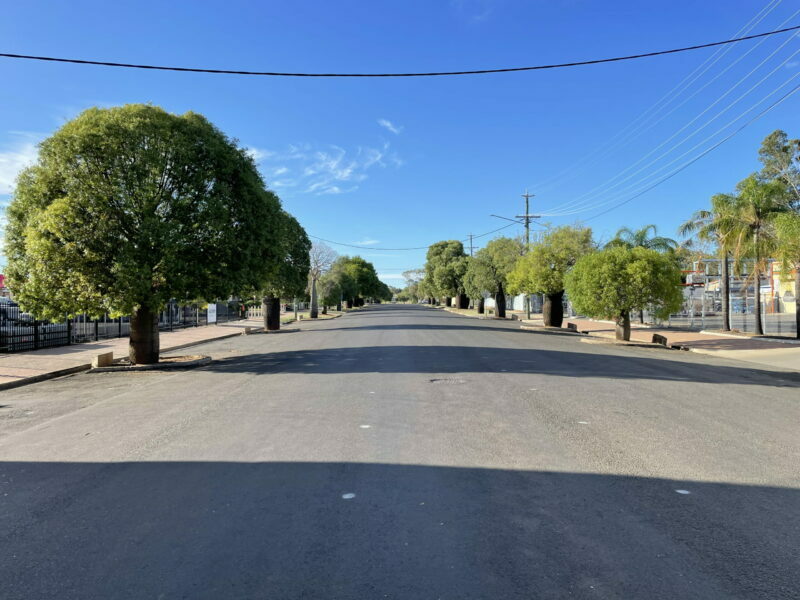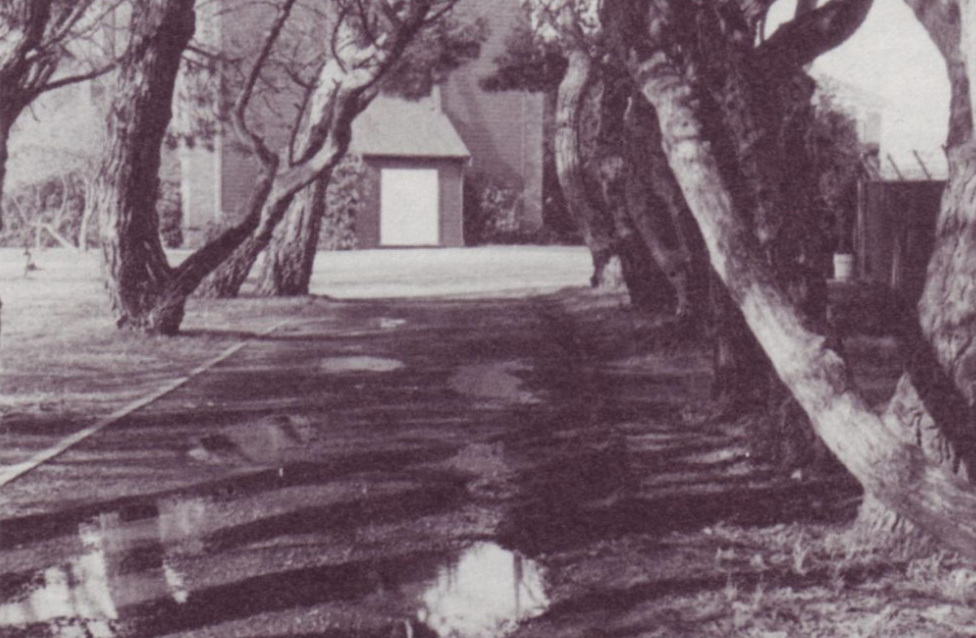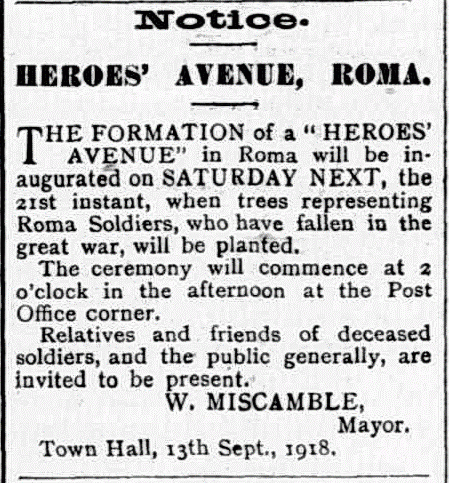
Roma’s living memorial, their Heroes Avenue, consisting of some 93 Queensland Bottle Trees (Brachychiton rupestris), was planted between 1918 to 1920, to honour the service and sacrifice of WW1 soldiers from the district.
Each tree was matched with an accompanying, brass name plate.
A tree commemorating Lance Corporal Norman Saunders, who was killed in France in 1916 during World War One, was the first of the 93 bottle trees planted and is at the site of the cairn. (A great series of images of current memorial signs and plaques, is available via the Virtual War Memorial Australia website)
HEROES’ AVENUE.
There was large gathering at Wyndham-street yesterday afternoon, when the first trees in Heroes’ Avenue were planted.
His Worship the Mayor (Ald. Miscamble) explained the object of the gathering, and apologised for the absence of the Rev. Father Hennessy, Rev. A. E. Henry, and Rev. Martin. He was sorry to learn that the Rev. Henry had that afternoon received the sad news, that his brother had been killed in action in France. Over four years ago war broke out, and it was not finished yet. The news lately was particularly cheering, and he thought the war would be over in another year. Since the outbreak of war 1200 men had enlisted from the Roma district, of whom 76 had been killed. They had met that day to pay their respect to the departed. Twenty-seven trees were to be planted in honor of the boys who had attended the local State school. Pte. F. Bartlem was the first of them to pay the supreme penalty. He admired the men whose souls were big enough to go and volunteer to fight the enemy of humanity and civilisation.
Rev. J. Muir said they had been called to do honor to those heroes who had given their lives for their country. The men who had responded to their country’s call had realised the very highest ideals of life. True living and true happiness was to be found in the service, rendered to others. The boys who would not come back were not dead. Their lives would live on. As long as Roma existed they would never be forgotten.
The first tree was planted in memory of Norman Saunders by the Mayor and Mrs. Spence at the Post Office corner. While planting a tree in front, of the school in memory of a teacher, Lieut. G. J. Sheppard, the children sang “God Speed the Right” very impressively indeed.
Mr. C. D. O’Brien P.M., referred to the splendid national spirit which ani-mated Belgium to turn a deaf ear to Germany’s peace proposal. Some people said Australia became a nation when the States were formed into a Commonwealth, but others said Australia rose to nationhood on the 25th April, 1915, at Gallipoli.
Mr. J. R. Mayfield, head teacher, also spoke, and referred to the many noble and loving traits in Lieut. Sheppard’s character, which made him respected by one and all.
Trees were planted in honor of the following :- N. Saunders, F. Bartlem, N. Crawford, P. Browne, D. Murphy, H. McKenzie, T. R. Twine, F. Warren, – Newbould, P. Walsh, W. Waters, A. Stein, P. F. Green, P. Crowley, S. Sheridan, H. Walters, G. J. Sheppard, W. Shambrook, J. Bond, C. Byan, N. Henderson, F. Burtleshaw, G. Brown, J. Greenan, W. Brion, and C. Macfarlane.
Western Star and Roma Advertiser (Qld. : 1875 – 1948), Saturday 21 September 1918, page 2
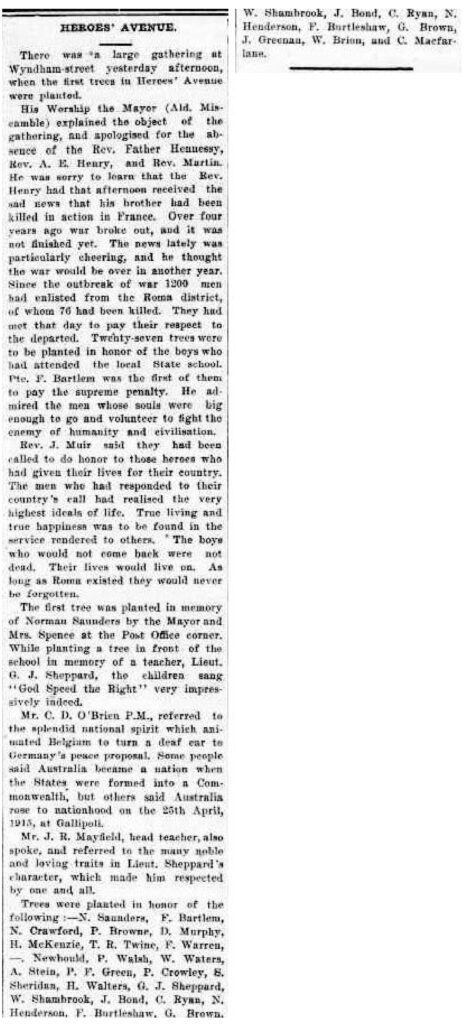
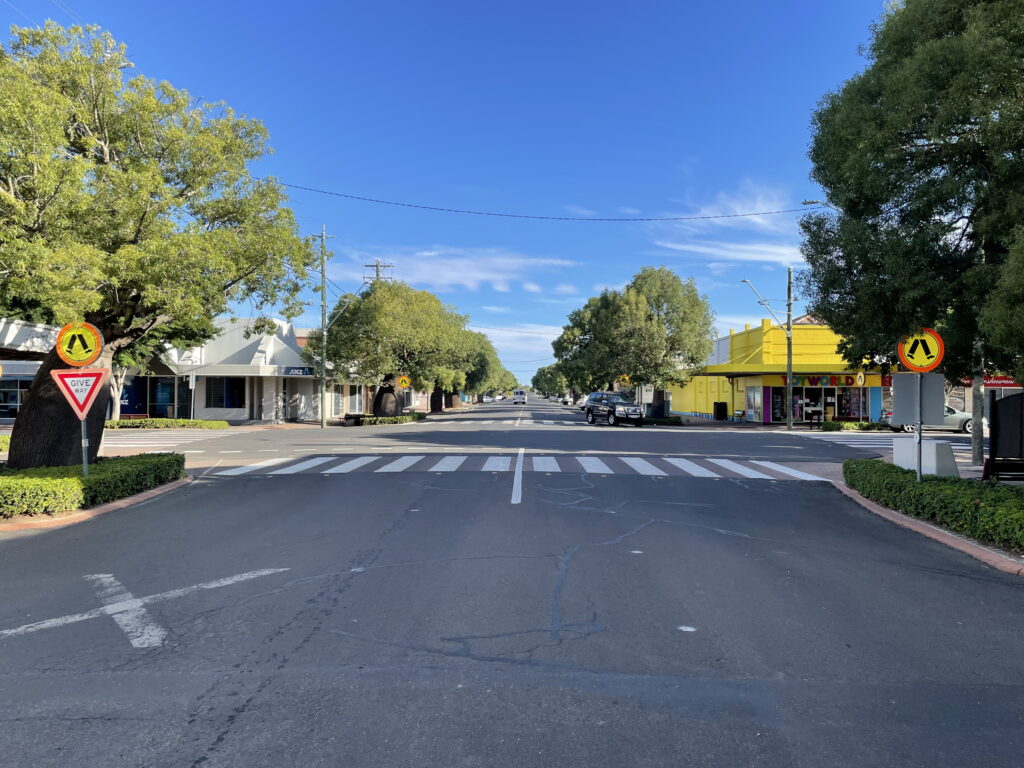
Of the original, brass name plates, only one plate survives and it has become part of a cairn identifying all 93 names, which is outside the Roma Post Office.
This view looks south down Wyndham Street and the white cairn can be seen behind the pedestrian crossing sign, Post Office is on the right.
Image courtesy of Kym Crettenden, April 2023
The current avenue of trees extends from the Railway Station (Station Street), turns right/north into Wyndham Street and after several blocks turns left/west into Bungil Street ending around the right/north corner of the intersection with the Carnarvon Highway.
Over 1.3 kms in length, the now very mature Bottle Trees provide a series of stunning streetscapes.

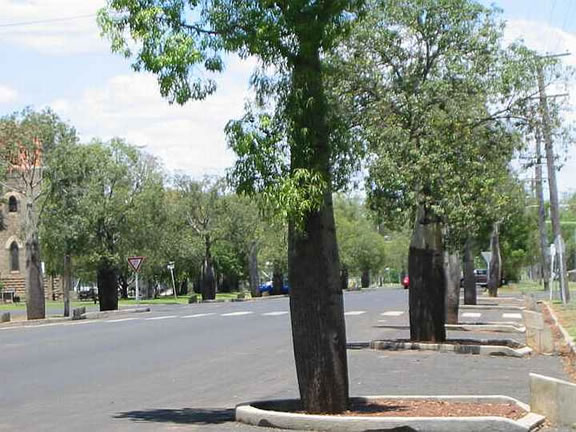 | 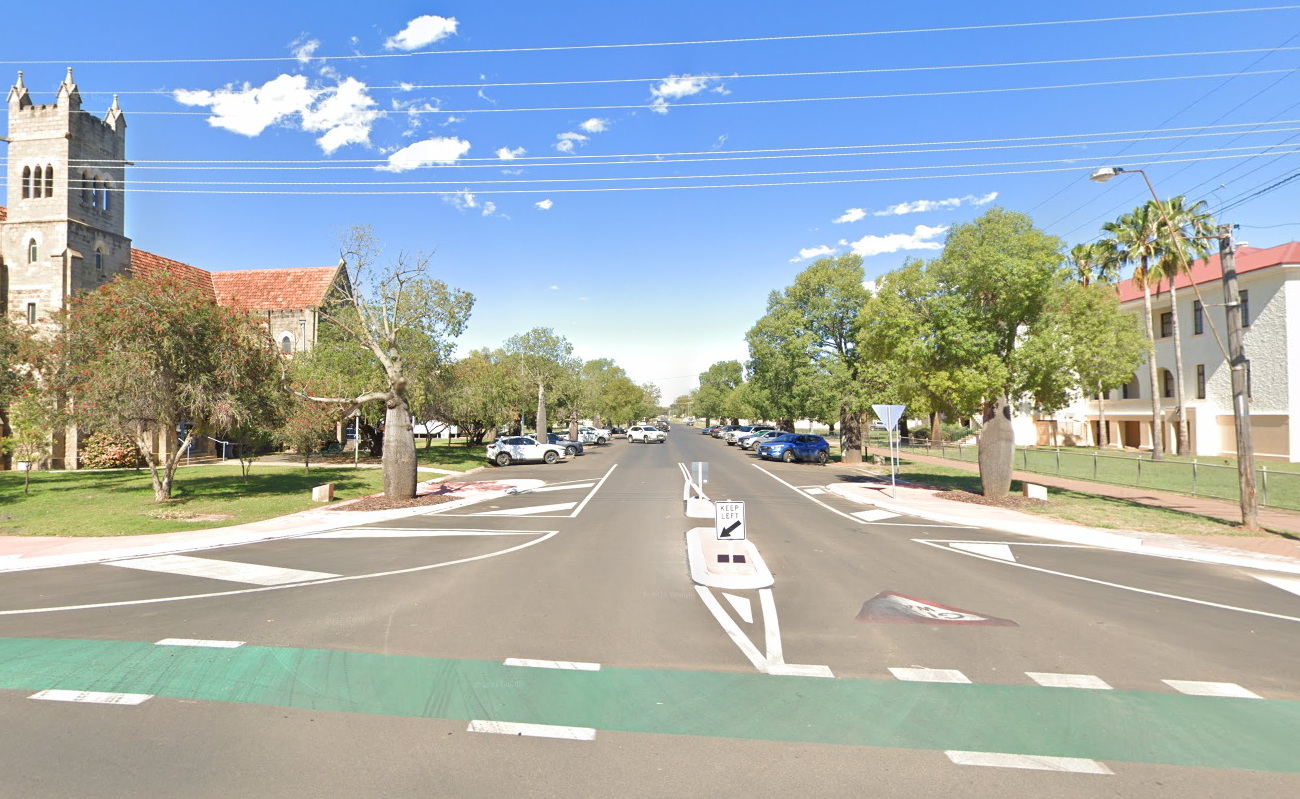 |
| This view is looking east along Bungil Street, past St Pauls Anglican Church. (Image: TREENET, March 2004) | A similar view, October 2021. (Image: Google Maps street view.) |
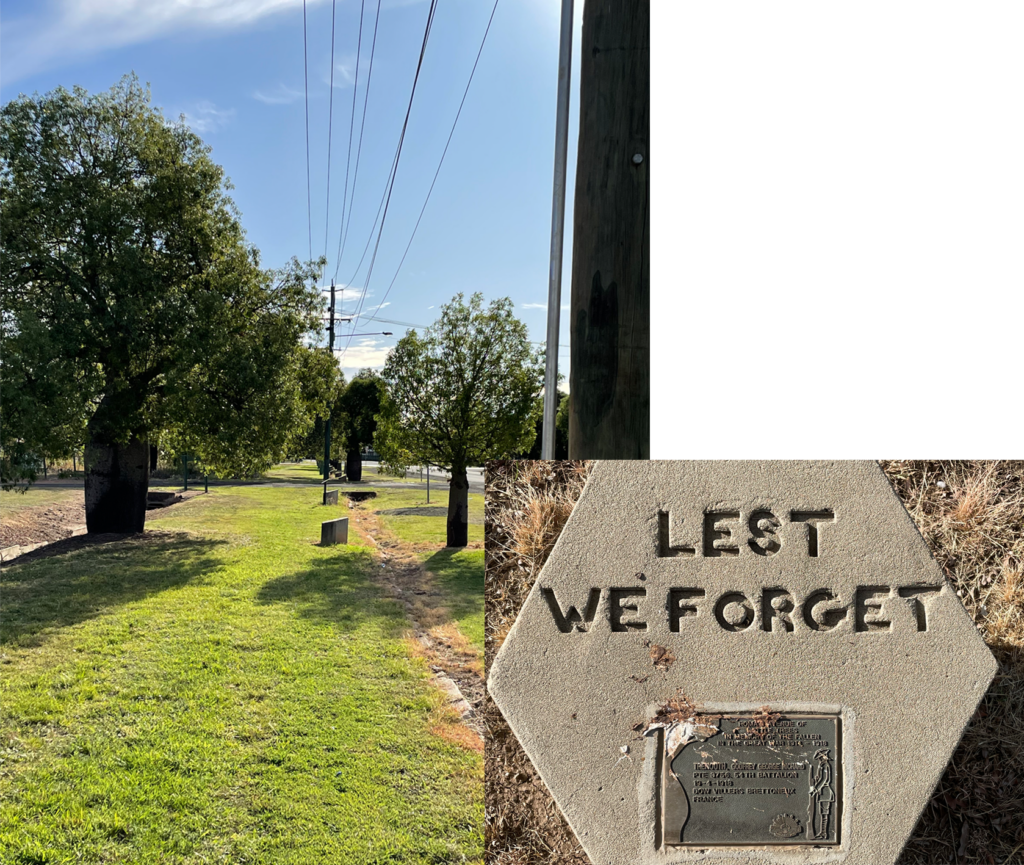
As part of historical refurbishment, most of the avenue trees now feature a plinth with details of a particular servicemen honoured.
Images courtesy of Kym Crettenden, April 2023
Why the Queensland Bottle Tree?
There is no doubt the current generation appreciate the visionary use of long-lived, tree species (both ornamental and native), that are testament to the origins of many of Australia’s established, early living memorials. Including the now impressive specimens featuring in the landscape, such as Monterey Cypress (Cupressa macrocarpa), English Oak (Quercus robur), English Elms (Ulmus procera), Plane Trees (Platanus spp.), WA Red-flowering Gum (Corymbia ficifolia), Sugar Gum (Eucalyptus cladocalyx), Kurrajong (Brachychiton populneus) and including the Queensland Bottle Tree (Brachychiton rupestris).
Clearly discussions were held in Roma during WW1, regarding options for a choice of species, and guidance was provided locally and at the state level . . .
Heroes’ Avenue.
At a meeting of the Town Council on Wednesday, the Mayor Ald. Miscamble, said he had been thinking of some way in which they could perpetuate the memory of our brave boys who had made the supreme sacrifice in fighting for us. Only that day, he had seen in the papers where a lad born at Roma had been killed at the front: V. Maguire, whose father was once in business here; and last week the sad news of two others having sacrificed their lives came through to us, and he thought the least they could do was to keep their memory green. He suggested they should hold an Arbor Day in July next, and plant a tree in memory of every lad who had gone from Roma. He knew the business men did not like trees, but there was room enough in the streets to have a garden in each, and the town would be made more beautiful. He further suggested that they should plant trees from the post office corner to the public school the school the boys came from, and that these trees form an avenue to be called “Heroes Avenue,” also, that Arthur street be planted with trees in memory of the men. He moved that arrangements be made for holding an Arbor Day in July next; and that they plant a tree in memory of each lad and man. It would, he said, create a national spirit, and also show loyalty to the dead.
Ald. Wright said he had great pleasure in supporting the Mayor’s proposal. Ald. Williams also supported the Mayor’s idea, but said they should get something better than pepperina trees.
The Mayor said he was not in favor of pepperina trees.
Ald. Dunstan said bottle trees were dirty; apple trees would be better, he thought.
Ald. Crawford also supported the motion and said a resident of Roma had a Moreton Bay fig tree growing in his garden, and it was a revelation to him. He did not know that kind of tree would grow in the west. It would he thought, be a good idea for them to experiment with the Moreton Bay fig, to see if they would be suitable for the streets.
The Mayor said they would have to be planted a good distance from the water tables or the roots would lift them.
Ald. Wright seconded the motion which was carried unanimously.
Western Star and Roma Advertiser (Qld. : 1875 – 1948), Saturday 27 October 1917, page 3
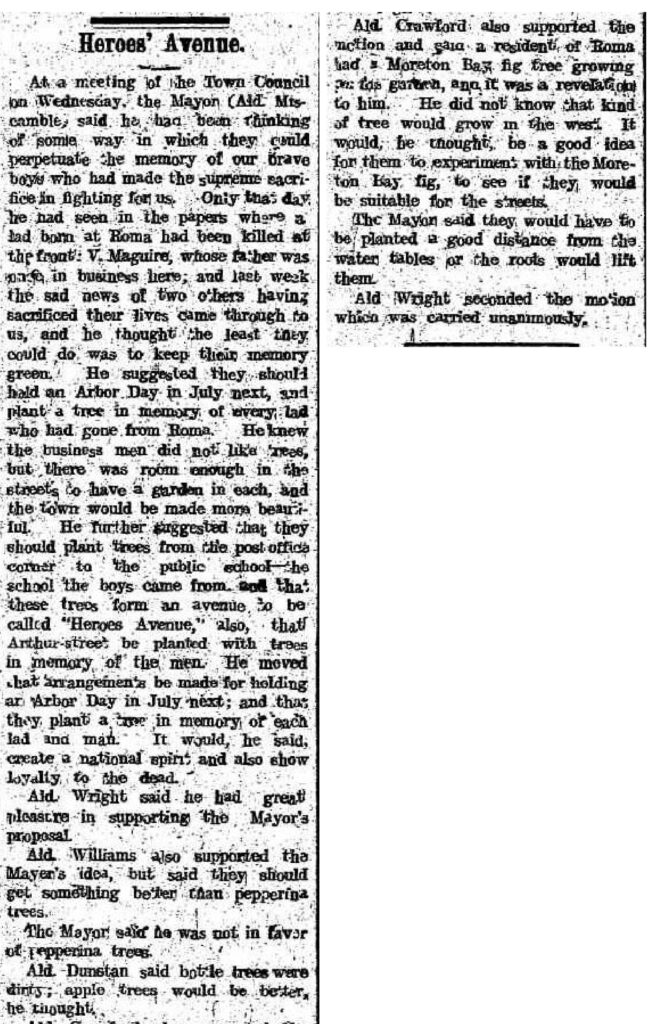
HEROES AVENUE
In connection with the proposal to plant an avenue of trees between the Post Office and the State School in memory of those gallant boys who have made the supreme sacrifice while fighting for their country, Mr E. W. Bick, Curator of the Botanic Gardens, Brisbane, sent the following letter to the local Town Council:-
I note your remarks re the pepperina and white cedar, but certainly think you ought to feature the bottle tree largely, as it is without doubt one of the most striking trees of the Queensland flora. The following list should provide suitable trees for your purpose:-
Sterculia ruprestris, bottle tree of your district; Sterculia tricosiphon, broad-leaved bottle tree; Sterculia diversifolia, kurrajong; albizzia lebbek; albizzia stipulata; albizzia fastigiate; eucalyptus melliodora, yellow box; eucalyptus hemiphloin, gum-toppped box; eucalyptus microcoria, tallow wood; eucalyptus populifolia, poplar box of your district; celtis australis, celtis kraussiana, fast growing trees, but deciduous; Caesalpinia ferrea; pithecolobium saman, rain tree; ceratonin siliqua, carob bean, largely grown in South Australia; crythrinn indica, very thick in growth, good flowering tree; calodendron capense, Cape Chestnut, fine compact growth, good tree; quercus serrata, Japanese oak, makes a fine tree.
I shall be pleased to assist your Council, by supplying a quantity of trees when you are ready for them. The best planting season is from about the middle of May until the end of August, in cold districts planting is best delayed until the worst of the cold weather is over.
Western Star and Roma Advertiser (QLD: 1875 – 1948), Saturday 20 April 1918 – Page 3


